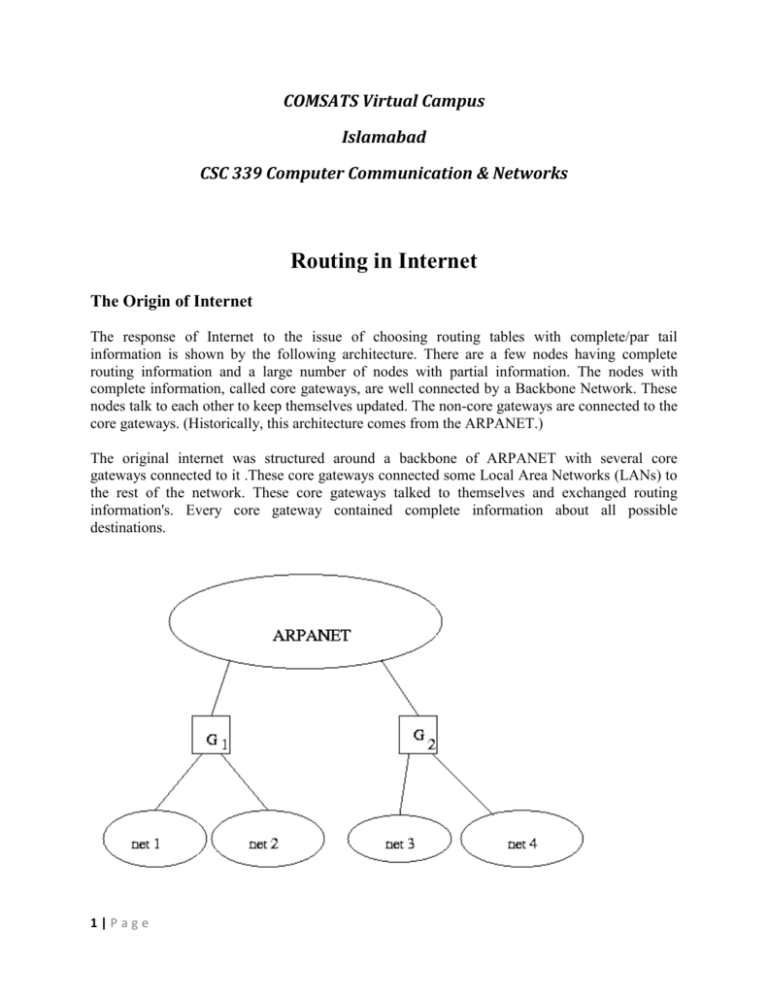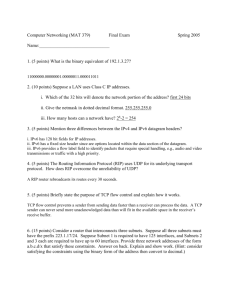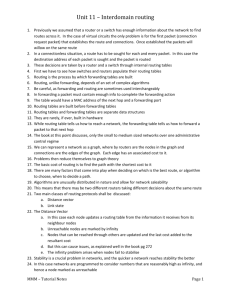handout 14
advertisement

COMSATS Virtual Campus Islamabad CSC 339 Computer Communication & Networks Routing in Internet The Origin of Internet The response of Internet to the issue of choosing routing tables with complete/par tail information is shown by the following architecture. There are a few nodes having complete routing information and a large number of nodes with partial information. The nodes with complete information, called core gateways, are well connected by a Backbone Network. These nodes talk to each other to keep themselves updated. The non-core gateways are connected to the core gateways. (Historically, this architecture comes from the ARPANET.) The original internet was structured around a backbone of ARPANET with several core gateways connected to it .These core gateways connected some Local Area Networks (LANs) to the rest of the network. These core gateways talked to themselves and exchanged routing information's. Every core gateway contained complete information about all possible destinations. 1|Page How do you do routing ? The usual IP routing algorithm employs an internet routing table (some times called an IP routing table) on each machine that Stores the information about the possible destinations, and how to reach them. Default Routes This technique used to hide information and keep routing table size small consolidates multiple entries into a default case. If no route appears in the routing table, the routing routine sends the data gram to the default router. Default routing is especially useful when a site has a small set of local addresses and only one connection to the rest of the internet. Host-Specific Routes Most IP routing software allows per-host routes to be specified as a special case. Having per-host routes gives the local network administrator more control over network use, permits testing, and can also be used to control access for security purposes. when debugging network connections or routing tables, the ability to specify a special route to one individual machine turns out to be especially useful. Internet with Two Backbones As long as there was just one single router connecting ARPANET with NSFNET there was no problem. The core gateways of ARPANET had information about all destinations and the routers inside NSFNET contained information about local destinations and used a default route to send 2|Page all non-NSFNET traffic to between NSFNET and ARPANET as both of them used different matrices to measure costs. the core gateways through the router between ARPANET and NSFNET. However as multiple connections were made between the two backbones, problems arise. Which route should a packet from net1 to net2 take? Should it be R1 or R2 or R3 or R4 or R5? For this some exchange of routing information between the two backbones was necessary. But, this was again a problem as how should we compare information. Gateway-To-Gateway Protocol (GGP) This was the protocol used by the core-routers to exchange routing information among themselves. This is based on Distance Vector Algorithm and uses number of hops as the distance metric. This is a very poor metric as this does not take into account the load on the links and whether a link is slow or fast. A provision is made to manually increment the hop count in case a link is particularly slow.A protocol based on Shortest Path First Algorithm , known as SPREAD ,was also used for the same purpose. Added Complexity To The Architecture Model As the number of networks and routers increased, to reduce the load on the core gateways because of the enormous amount of calculations, routing was done with some core gateways keeping complete information and the non-core gateways keeping partial information. 3|Page In thisarchitecture, G1 ,G2 ,G3 are all core gateways and G4 and G5 are non-core gateways. We must have a mechanism for someone to tell G2 that it is connected to net2 , net3 and net4 , besides net1. Only G5 can tell this to G2 and so we must provide for a mechanism for G2 to talk to G5 . A concept of one backbone with core gateways connected to Autonomous Systems was developed. An Autonomous system is a group of networks controlled by a single administrative authority. Routers within an autonomous system are free to choose their own mechanisms for discovering , propagating ,validating , and checking the consistency of routes. Each autonomous system must agree to advertise network reachability information to other autonomous systems. Each advertisement propagates through a core router. The assumption made is that most of the routers in the autonomous system have complete information about the autonomous system. One such router will be assigned the task of talking to the core gateway. Interior Gateway Protocols (IGP) IGP is a type of protocols used by the routers in an autonomous system to exchange network reachability and routing information. Some of IGPs are given below. Routing Information Protocol (RIP) This is one of the most widely used IGP. It was developed at Berkeley. This is also known by the name of the program that implements it, routed .This implements Distance Vector algorithm.Features of RIP: 4|Page RIP uses a hop count metric to measure the distance to a destination. To compensate for differences in technologies, many RIP implementations allow managers to configure artificially high hop counts when advertising connections to slow networks. All routinfg updates are broadcast. This allows all hosts on the network to know about the routes. To prevent routes from oscillating between two or more equal cost paths, RIP specifies that existing routes should be retained until a new route has strictly lower cost. Since RIP does not explicitly detect routing loops, RIP must either assume participants can be trusted (being part of one autonomous system) or take precautions to prevent such loops. To prevent instabilities, RIP must use a low value for the maximum possible distance.RIP uses 16 as the maximum hop count. This restricts the maximum network diameter of the system to 16. To solve the slow convergence problem arising due to slow propagation of routing information, RIP uses Hold Down. If a particular link is down , any new information about that link is not accepted till some time. This is because the router must wait till the information aboutthe link being down propagates to another router before accepting information from that router about that down link. RIP runs on top of TCP/IP. RIP allows addresses to be of a maximum size of 14 Bytes. The Distance varies from 1 to 16 (where 16 is used to signify infinity). RIP address 0.0.0.0 denotes a default route. There is no explicit size of the RIP message and any number of routes can be advertized. The message format is as shown: 5|Page OSPF(Open Shortest Path First ) This is an Interior Gateway Protocol designed by the Internet Engineering Task Force ( IETF ). This algorithm scales better than the vector distance algorithms. This Protocol tackles several goals: OSPF includes type of service(ToS) routing. So, you can installmultiple routers to a given destination, one for each type of service. When routing a datagram, a router running OSPF uses both the destination address and type of service fields in the IP Header to choose a route. OSPF provides load balancing. If there are multiple routes to a given destination at the same cost, OSPF distributes traffic over all the routes equally. OSPF allows for creation of AREA HIERARCHIES. This makes the growth of the network easier and makes the network at a site easier to manage. Each area is self contained, so, multiple groups within a site can cooperate in the use of OSPF for routing. OSPF protocol specifies that all exchanges between the routers be authenticated. OSPF allows variety of authentication schemes, and even allows one area to choose a different scheme from the other areas. 6|Page To accomodate multi-access networks like ethernet, OSPF allows every multi-access network to have a designated router( designated gateway). To permit maximum flexibility, OSPF allows the description of a virtual network topology that abstracts away from details of physical connections. OSPF also allows for routers to exchange routing information learned from other sites. The message format distinguishes between information acquired from external sources and information acquired from routers interior to the site, so there is no ambiguity about the source or reliability of routes. It hastoo much overhead of sending LSPs but is gradually becoming popular. Exterior Gateway Protocol (EGP) If two routers belonging to two different autonomous systems exchange routing information ,the protocol used is called EGP . EGP consists of: Acquisition Request: A router sends a request to another neighbour router saying 'I want to talk'. Acquisition Confirm: This is a positive reply to the Acquisition request. Acquisition Refuse: This is a negative response to the Acquisition request. Cease Request: This requests termination of neighbour relationship. Cease Confirm: This is a confirmation response to the Cease Request. Hello : This is used to find if the neighbour router is up or down.This requests router to respond if alive. I Heard You: This is a response to the Hello message confirming that the router is alive. Because it is possible for Hello or I Heard You messages to be lost in transit, EGP uses a k-out-of-n rule to determine whether a network is down.At least k of the last n messages must fail for the router to declare its neighbour down. Poll Request: This is a request for network routing update. Routing Update: This conveys routing information about reachable networks to its EGP neighbour. The routing information is the distance vector of the reachable networks. Error: This is a response to an incorrect message. 7|Page EGP is used only to find network reachability and not for differentiating between good and bad routes. We can only use distance metric to declare a route plausible and not for comparing it with some other route (unless the two route form part of a same autonomous system). Since there cannot be two different routes to the same network, EGP restricts the topology of any internet to a tree structure in which a core system forms the root. There are no loops among other autonomous systems connected to it. This leads to several problems: Univerasal connectivity fails if the core gateway system fails. EGP can advertise only one path to a given network. EGP does not support load sharing on routers between arbitrary autonomous systems. Multiple backbone networks with multiple connections between them cannot be handled by EGP. Border Gateway Protocol(BGP) BGP is a distance-vector protocol used to communicate between different ASes. Instead of maintaining just the cost to each destination,each BGP router keeps track of the exact path used.Similarly,instead of periodically giving each neighbour its estimated cost to each destination, each BGP router tells its neighbours the path it is using.Every BGP router contains a module that examines routes to a given destination and scores them returning a number for destination to each route. Any route violating a policy constraint automatically gets a score of infinity. The router adapts a route with shortest distance.The scoring function is not a part of the BGP protocol and can be any function that the system managers want.BGP easily solves the count to infinity problem that plagues other distance-vector algorithms as whole path is known. Routing (Continued) Shortest Path Algorithm 1. Dijktstra's Algorithm: At the end each node will be labeled (see Figure.1) with its distance from source node along the best known path. Initially, no paths are known, so all nodes are labeled with infinity. As the algorithm proceeds and paths are found, the labels may change reflecting better paths. Initially, all labels are tentative. When it is discovered that a label represents the shortest possible path from the source to that node, it is made permanent and never changed thereafter. Look at the weighted undirected graph of Figure.1(a), where the weights represent, for example, distance. We want to find shortest path from A to D. We start by making node A as permanent, indicated by a filled in circle. Then we examine each of the nodes adjacent to A (the working node), relabeling each one with the distance to A. Whenever a node is relabeled, we also label it with the node from which the probe was made so that we can construct the final path later. Having examined each of the nodes adjacent to A, we examine all the tentatively labeled nodes 8|Page in the whole graph and make the one with the smallest label permanent, as shown in Figure.1(b). This one becomes new working node. We now start at B, and examine all nodes adjacent to it. If the sum of the label on B and the distance from B to the node being considered is less than the label on the node, we have a shorter path, so the node is relabeled. After all the nodes adjacent to the working node have been inspected and the tentative labels changed if possible, the entire graph is searched for the tentatively labeled node with the smallest value. This node is made permanent and becomes the working node for the next round. The Figure. 1 shows the first five steps of the algorithm. Note: Dijkstra's Algorithm is applicable only when cost of all the nodes is non-negative. 2. Bellman Ford's Algorithm: We look at the distributed version which works on the premise that the information about far away nodes can be had from the adjoining links. The algorithm works as follows. o o o 9|Page Compute the link costs from the starting node to every directly connected node . Select the cheapest links for every node (if there is more than one) . For every directly connected node, compute the link costs for all these nodes. o Select the cheapest route Repeat until all nodes have been processed. for any node . Every node should have the information about it's immediate neighbors and over a period of time we will have information about other nodes. Within n units of time , where n is the diameter of the network, every node will have the complete information. We do not need to be synchronized i.e. do not need to exchange information at the same time. Routing algorithms based on Dijkstra's algorithm are called Link State Algorithms. Distance Vector Protocols are based on distributed Bellman's algorithm. In the former we are sending little information to many nodes while in the latter we send huge information to few neighbors. Count-to-Infinity problem: Suppose the link between A and E is down events may occur are: (1) F tells A that it has a path to E with cost 6 (2) A sets cost to E to be 11, and advertise to F again (3) F sets the cost to E to be 16, and advertise to A again This cycle will continue and the cost to E goes to infinity. The core of the problem is that when X tells Y that it has a path somewhere ,Y has no way to know whether it itself is on the path. During this process of counting to infinity, packets from A or F destined to E are likely to loop back and forth between A and F, causing congestion for other packets. 10 | P a g e Example to illustrate bad Routing Protocol : Design of a bad routing protocol can lead to highly undesirable results. Consider the following scenario to understand this. We are having 16 nodes logically connected in a ring as shown in Figure1. Each node sends one unit of data in unit time except one node Q which sends e (0<e<1) unit of data in unit time. We consider cost of the link as the traffic in that link. We consider P as the only receiver in the ring. Now Ideally we must have nodes left of the diagonal PQ sending data clockwise and that on the right of the PQ counterclockwise as shown in Figure 2. We may assume that Q sends data counterclockwise. Assume that this ideal distribution was achieved at some time. Now we can see that cost of links to the left of PQ are respectively 1,2,3 ..,7 while that on the right of PQ are e,1+e,2+e ..,7+e. Therefore when we reconsider the shortest path the node immediately to the right of Q will see traffic 28 to the left while 28+7e to the right and therefore will start sending data clockwise and same is true for Q also. This will heavily change the traffic on the network. Now the traffic load will shift to the left of PQ and next reconsideration will make a lot of nodes from left of PQ send data counterclockwise. This may keep oscillating and will cost a lot to the network. To prevent these two steps can be taken : 1. Assign a minimum cost to each link. 2. Do not change the route until you get a significant advantage. 11 | P a g e








